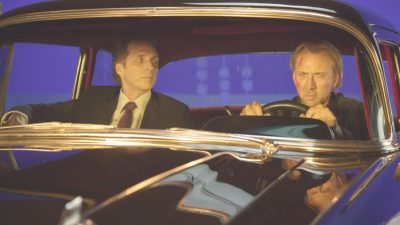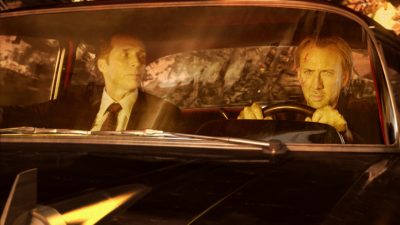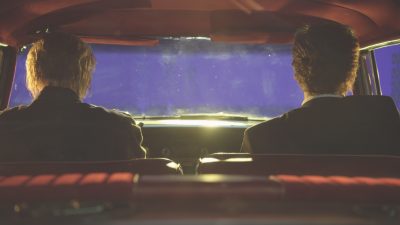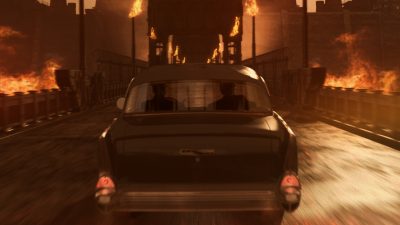Director Patrick Lussier’s Drive Angry 3D tells the fantastical story of a vengeful father who escapes from hell to save his granddaughter. VFX supe Glenn Neufeld takes us through the key effects shots and how he used them to help slowly reveal some of the film’s key surprises.
Neufeld describes the visual effects in Drive Angry as “sudden and colossal”, noting that at first the audience is given only very brief moments or hints that the main character, Milton (Nicolas Cage), may be more than what he seems. We learn that a penitentiary Milton escapes from early in the film is in fact hell, as he seeks out members of a cult who murdered his daughter and now threaten to kill his granddaughter. Along the way, Milton is pursued by The Accountant (William Fichtner), an equally mysterious player in this journey.
Many of the film’s 520 effects shots were made up of foreground and background stereo composites, with early one-off shots designed to hint at the film’s supernatural elements. “The visual effects in the movie,” says Neufeld, “for 15 to 30 seconds at a time and at various places, are designed to reveal that Milton is no ordinary escaped convict and The Accountant is somewhat other-worldly. What ensues are lots of little looks of the powers that might be unleashed from hell, but only hints. Each of those little moments is an effect which leads up to the end of the film.”
To complete the effects work, Neufeld assembled a team of artists from Worldwide FX, as well as specialised freelancers brought on board for shots of a ‘God Killer’ weapon and views of the supposed penitentiary that Milton escapes from.
The evolution of the God Killer
At one point in the film, The Accountant catches up with Milton, who fires on but only slightly injures his pursuer with an ancient-looking weapon – the God Killer – that was stolen from hell. “At first you see this spectacular bullet that’s fired from one car to another,” explains Neufeld, “and all of a sudden you’re in a completely different world. It’s designed to make the audience say ‘What the hell is that?’ This is the first moment in the first Act where you realise something peculiar is going on.”
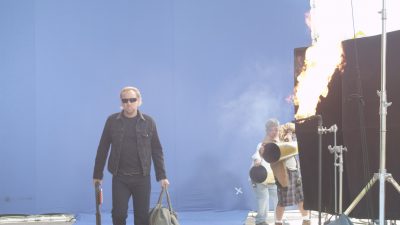
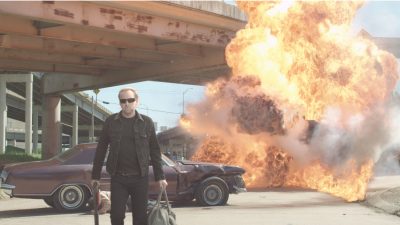 A prop God Killer gun was created for filming by special makeup effects designer Gary Tunnicliffe, with a matching old-worldly looking case and bullets. “The idea behind the God Killer,” says Neufeld, “was to give the audience something supernatural which could defeat the kind of person Milton is running away from, but also to show the mega implications of what might happen when it is used.”
A prop God Killer gun was created for filming by special makeup effects designer Gary Tunnicliffe, with a matching old-worldly looking case and bullets. “The idea behind the God Killer,” says Neufeld, “was to give the audience something supernatural which could defeat the kind of person Milton is running away from, but also to show the mega implications of what might happen when it is used.”
Initially, the design of the God Killer blast took on a decidedly cosmic appearance. “Our take on it was basically the end of everything,” says Neufeld. “Destroying a God would release titanic energies that then destroy everything. In the design of the bullet, what I was trying to do was make it look completely other-worldly when seen from the side. The trails would stream off the bullet, but then as the camera came around the bullet, all of these trails would stack up on top of each other and become foreshortened. Essentially, it was to look like an image of the spiral galaxy for a moment as the camera crosses the axis of the bullet.”
“We worked on several iterations of what the trails looked like and debris and the particles,” continues Neufeld. “There was one moment of a few frames in slow motion where you suddenly get this glimpse of the universe. You realize that all of the things you see don’t make sense unless you see them from the right angle. The idea was to make it look like the Milky Way, just for a beat.”
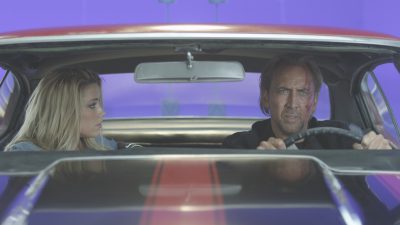
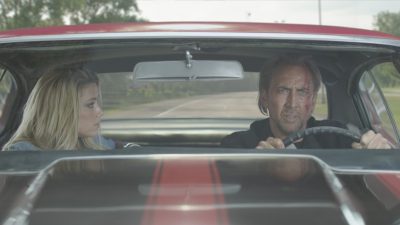 Ultimately, to help reveal more of the supernatural elements to the audience, the cosmic nature of the shot was changed. “What we found after shooting all the passes for having the bullet cross, and the background plates and the car,” says Neufeld, “was that it was much more fun to show The Accountant’s reaction. Milton is also driving with his companion (Amber Heard) and she’s sitting in the back seat of the car when he fires the bullet, so we changed the shots around so you could see everybody’s face as the gun fires.”
Ultimately, to help reveal more of the supernatural elements to the audience, the cosmic nature of the shot was changed. “What we found after shooting all the passes for having the bullet cross, and the background plates and the car,” says Neufeld, “was that it was much more fun to show The Accountant’s reaction. Milton is also driving with his companion (Amber Heard) and she’s sitting in the back seat of the car when he fires the bullet, so we changed the shots around so you could see everybody’s face as the gun fires.”
As the trigger is pulled, time stops around the God Killer, although the traditional bullet-time look was something Neufeld wanted to take further. “Everything comes to a complete stop and the bullet keeps moving in what is apparently slow motion, but then when you see The Accountant reacting to it you realize that he is a character who can move fairly quickly in zero time. The whole shot lasts about 15 seconds, but we try and jam in all of that information.”
For the look of the God Killer bullets, work began with a traditional particle approach. “We had many iterations where we were choreographing the camera to a position looking right down the axis of the bullet at a certain moment in the shot,” says Neufeld. “Then we worked backwards to really make it look like it was a galaxy that you were seeing for a few frames. That was working really well, but then things changed when I realised I didn’t want it to be a traditional bullet-time shot. I rehashed it with Todd Farmer (the film’s co-writer) and Patrick over and over and realised we could show two or three different things in the space of a very short shot that were more important for the story than it was for the audience to suddenly see something.”
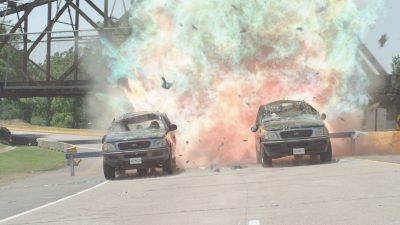
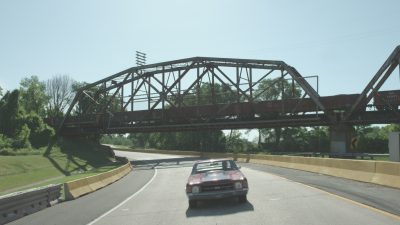
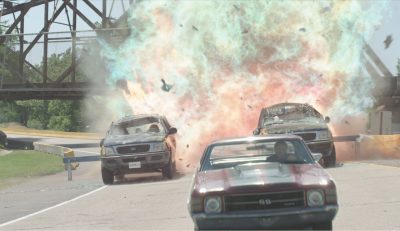
The choreography of the entire shot was changed and broken up into three shots that emphasized the frozen surroundings but also highlighted the fact that The Accountant could still move. “And once we’d done that,” recalls Neufeld, “we realized that the shot was about giving away some of the capabilities of The Accountant and seeing that people react differently to the weapon being fired compared with The Accountant. So in dispensing with the cosmic and the galaxy approach, we decided to show what firing the bullet means to all the characters in that moment.”
The initial God Killer scene is only a precursor, however, to what the weapon is really capable of. Later in the story, Milton uses the gun to spectacular effect on the cult leader. “It’s at that moment,” explains Neufeld, “that the streamers and the bullet trails start to animate and do things on their own. They change their position and reach out like a squid’s tentacles and grab onto things and pull them along and do other wonderful things that you see in the final Act of the movie.” For these more elaborate God Killer effects, artists used mostly Lightwave to realize the streams and trails as organic-looking particles.
Milton’s eyelid
In another reveal as to his true nature, Milton is shot in the head but continues on his mission with a bandaged face. After removing the bandage, the audience sees that part of his eye has grown back. “What we all wanted to do was to see a tiny bit of that growing back process and have it be completely strange and counter-intuitive and weird,” says Neufeld. “One of the things we came up with for reference was animals that have a meniscus or an eyelid that they can close, like the semi-transparent eyelid of a crocodile that protects its eye but lets it see underwater.”
Artists tracked Nicolas Cage’s face and animated a slightly messed up eyelid. “When Milton looks in the mirror to see what’s happening with his face,” says Neufeld, “his eye looks like this horrible black mass and then you see these two semi-transparent eyelids slide away revealing that his eye has grown back. That was one of the gags that worked really well for the story because it’s another giant question mark that they throw up in the air for the audience.”
“It’s also triple-ly icky-looking in stereo. You get that very slight hint autonomically when you’re looking at things in 3D that this meniscus is on top of his eye, yet below his normal eyelid. So it feels like there’s something happening in his head when you look at it. We did some other little tricks too, like deliberately throwing the stereo slightly out of kilter in a wider shot that’s similar to that. So you get a bit of eye pull where the gag is happening but not enough to cause any pain.”
Seeing hell, other effects and making it work in 3D
Although Milton is shown escaping a penitentiary early on, its true nature as the location of hell is not revealed until the film’s conclusion. That ending starts with The Accountant conjuring an old classic car to return Milton to hell. “The appearance and disappearance of the car was a huge combination of all different things,” says Neufeld. “We combined practical elements, light elements, CG particles and mattes. It’s the one moment where the world of Hell and our world come together. A lot of work went into the design of what’s seen through the back windows. The trick was to not give away that it’s another universe they come from, but then at the end of the movie, it was supposed to telegraph in a big way that where they came from was not a normal place.”Other effects in the film involved pieces of flying 3D debris, weapons, bullet hits, as well as numerous bluescreen driving composites. CG vehicles were also created for a sequence in which Milton comes up against a police road block, which is disrupted by The Accountant driving a hydrogen truck.
To shoot Drive Angry stereoscopically, production relied on Paradise FX TRIDELTA camera systems, employing RED and Silicon Image 2K cameras. Neufeld built an interface to Paradise’s cameras that allowed him to record interocular and convergence information to match the visual effects and background plates. “We would use that recorder and then replicate the data in CG to directly render the left and right eye with the matching perspective for the shots,” says Neufeld.
“However, we had to do some manual work before I got the recorder working properly. What we did was force the stereo depth to be shallow in the foreground knowing we could start the stereo depth of the backgrounds at the same shallow spot and yet run the back of them all the way out to infinity, which turns out to be three to five per cent off-set, when you look at the rendered frames.”
Effects to tell the story
“In visual effects,” notes Neufeld, “there’s always this desire to have something spectacular and something no one’s ever seen before. My wish with Drive Angry was for the visual effects to of course help tell the story but also to only help give away parts of the story when necessary. So, for example, in the closing visual effects where Milton acquiesces about being brought back to hell, the effects here serve to highlight that the prison he sought to escape from is a lot more spectacular and other-worldly than you first imagined.”
Neufeld credits the writer/director team for ensuring the visual effects fit neatly into Drive Angry’s timeline of reveals. “The story was so finely tuned. It also had a highly obfuscated, internal consistency of what you get to see happen that you don’t understand. The rules might not make any sense, but if you stick to the rules you’ve created within your universe then people can believe it. Patrick and Todd have created an entire way to join the universes of heaven, hell and the earth, and I think they’ve now also added to the repertoire the stories you can tell in sci-fi.”

